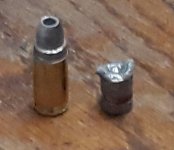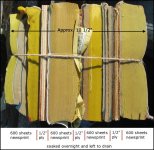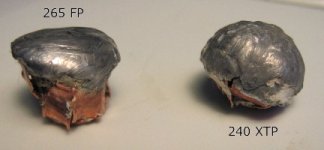Years ago I started an experiment to test the viability of heavy 9mm lead bullets as a defensive round. I was stymied by a lack of available bullets (not ready to get into casting for experimental purposes) and lack of a suitable medium. I had these 9mm 160 grain SWCHP bullets left over and I got the idea to use Play-Doh from the internet (Gelatin is expensive, messy and needs refrigeration) and it sounded like a way to get the project finished. So I cooked up about 20 lbs.
I loaded them with Accurate #7 and Chrono'd about 950 fps out of a 5903. Then I shot them into the Play-Doh. The results were negative in the extreme.
The retained weight from the 160 gr bullet was 128.8 grains with a loss of 31.2 grains.
The 'expanded' confused
confused diameter was .455" on one axis and .359" rotated 90 degrees.
diameter was .455" on one axis and .359" rotated 90 degrees.
As seen in the picture, it expanded nicely down to the bottom of the hollow opening, but nearly every bit of lead that expanded sheared off.
I don't have a number for inches of penetration and it wouldn't matter anyway because Play-Doh doesn't have any standard for penetration.
Conclusion: These would 'work' as a defensive round, but much better and reliable performance can be had from available ammo.
No real surprise but I was hoping for better retained weight and expanded diameter than nil on both counts.
Well, on to the next project.
PS: One thing that enabled me to complete this is the improved state of my health AS LONG AS I can get the meds I need that are on constant backorder because they are prescribing it for weight loss when it was created and produced as a diabetic drug. (Ozempic) I've got a horror story that would be entertaining reading in the Lounge so maybe I'll post it there.
I loaded them with Accurate #7 and Chrono'd about 950 fps out of a 5903. Then I shot them into the Play-Doh. The results were negative in the extreme.
The retained weight from the 160 gr bullet was 128.8 grains with a loss of 31.2 grains.
The 'expanded'
As seen in the picture, it expanded nicely down to the bottom of the hollow opening, but nearly every bit of lead that expanded sheared off.
I don't have a number for inches of penetration and it wouldn't matter anyway because Play-Doh doesn't have any standard for penetration.
Conclusion: These would 'work' as a defensive round, but much better and reliable performance can be had from available ammo.
No real surprise but I was hoping for better retained weight and expanded diameter than nil on both counts.
Well, on to the next project.
PS: One thing that enabled me to complete this is the improved state of my health AS LONG AS I can get the meds I need that are on constant backorder because they are prescribing it for weight loss when it was created and produced as a diabetic drug. (Ozempic) I've got a horror story that would be entertaining reading in the Lounge so maybe I'll post it there.






